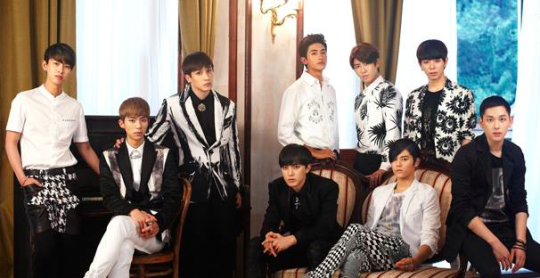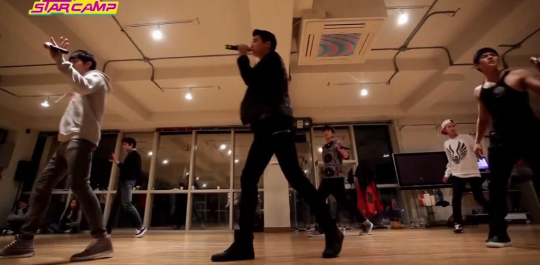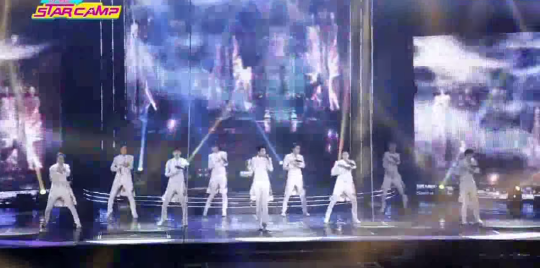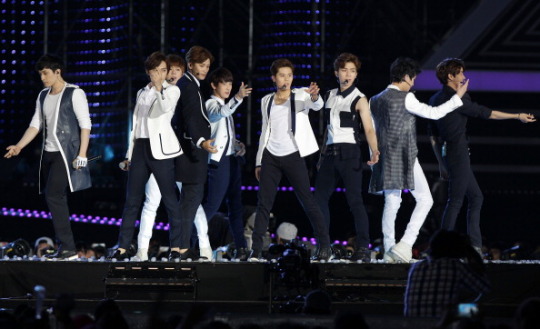Reviewed on January 1, 2015

Before this review starts, I would like to give a few excuses disclaimers. For one, as some readers may know, I do not possess an actual show review outline; my show reviews are a mixture of highlights and my general opinion of the show. That said, there is no numerical rating as seen in my song reviews. Secondly, since this show is not too popular, finding pictures to utilize is nearly impossible. As a result, to keep my tradition of how my show reviews contain pictures, I am putting extra effort by taking my own images from the show. Unfortunately, the downfall of that appears in the lower quality of the pictures. Apologies for such, and keep in mind, these show reviews can be considered moreover “bonus reviews” than dedicated, thorough ones. Music reviews will always remain my top priority.
Anyhow, to digress slightly more, I would like to give some comments in regards to T-ARA’s first home concert. T-ARA holds a special throne in that they are one of my personal favorite groups in general, and that I highly admire and look up to the ladies. Hopefully one day I am as intelligent and skilled as Soyeon (a huge role model to me), and that other traits such as being exceptionally friendly, responsible, caring, tough, and more, are also achieved. And, I also hope one day I will be as pretty as her, but that is impossible less important than the other significant characteristics. Back to the concert, after 5 years (I might be wrong with the years), T-ARA has finally had their first solo concert in their home country (they have done a few in Japan and China, but not Korea). It is incredible to see their growth over the years, and I hold high expectations on their future activities.
Going on another tangent, in regards to their song “ORGR,” there has been a lot of debate and confusion to the lyrics, and I will offer my own perspective on it (and at this point, feel free to skip below). Whether it is due to pure coincidence or clever composing (or simply pronunciation), the key phrase of the song can be considered a pun involving both languages of Korean and English. Firstly, “ORGR” is abbreviated for “Oh Ready Go Ready,” which is heard in the lyrics in the form of “oh ready, go ready, go.” This is where confusion occurs; people hear three phrases: “Oh ready, go ready, go,” or “Oh let it go, let it go,” or if taking account a Korean phrase of mockery (not too sure on this), a rough meaning of “Na na na.” So, to offer my own opinion, I believe T-ARA is saying the English phrase of “Oh ready, go ready” since the song title is the abbreviated form of those words. However, I find that the key phrase could also reflect the latter phrases. To explain why people hear “Oh let it go, let it go,” it has to do with the pronunciation of the English phrase of “ORGR.” The letter/sound “R” in English is replaceable with the letter/sound of “L” in Korean assuming the following letter is a vowel sound (for example, Sistar’s Hyorin can also be pronounced as “Hyolyn,” both are valid and correct; Rick can also be heard as “Lick,” and similarly, be correct) . This leads to “Oh ‘leady’ go,” but now you are wondering why the “D” sounds like a “T,” and that is simply that; in Korean, the English “D” sound/letter is a “T” sound. A simple example is the Korean slang/saying of “daebak” (means “awesome/amazing/cool”). In this case, the “D” sound is softer and moreover sounding like “taebak” for English. Factoring this into the equation, the phrase of “ORGR” now becomes “Oh ‘leaty’ go” which sounds like “Oh let it go.” As for the Korean mockery phrase, that is also correct to be heard (assuming I am accurate about the phrase). While “Oh ready, go ready, go” is heard as that in English, in Korean, the same sounding phrase could mean a teasing, mocking saying of “Na na na.” Anyhow, point is, regardless of what you hear, they all match the overall song’s lyrics, and in the end, all are technically accurate. Apologies if my formatting here induces eye strain.
Now ignoring the extremely confusing, unorganized language lesson, in terms of how T-ARA’s concert relates to “Star Camp,” I wondered how rigorous and strenuous the preparation leading up to the solo concert was; dancing and singing for hours is an extremely difficult feat, and thus, preparing for such an event would seem equally challenging. Thankfully, this show gives some insight. While it may not be focused on T-ARA, it does focus on idols who are equally charming, talented, and stunning as those ladies. ZE:A is a group I highly respect. If I recall properly, I believe I did a review on one of their songs, but considering it was during the newbie days, that review would hold as incohesive and horrendous. Perhaps a future review will need to be done to correct the past. Anyhow, whether it were songs that I overlooked such as “Step By Step,” singing and dancing skills, their humor, or their general sweet, affectionate interactions, “Star Camp” reminded me of how incredible these men were.
With all of that said, it is time to truly begin the review. The gentlemen of ZE:A held their own home concert a while back, and thanks to “Star Camp,” some behind-the-scene footages are revealed. Furthermore, for those curious on Star Empire Entertainment’s building (ZE:A’s label company; they also home Nine Muses, Jewelry, Soreal, and V.O.S), this show tours the place and reveals the layout. Is this show worth watching, and does it accurately depict ZE:A’s struggles? Through taking a camping trip to the land of the star idols of ZE:A, we will find out.

For the first section of “Star Camp,” touring Star Empire Entertainment’s building was the main objective. ZE:A’s hyung (used by males to refer to older males), Kevin, “good-looks” Heechul, and Jewelry’s sparkling Yewon were the hosts of the tour. They covered multiple stories (pun intended) of the company, and gave their own personal anecdotes such as trainee day experiences.


Peering at the first floor, there were two sections to cover: the cafeteria and the recording studio. For the cafeteria, besides some teasing on Yewon’s excitement to eat, “Star Camp” revealed the layout. Additionally, Kevin shared ZE:A’s trainee experience involving the place. Before they had a cafeteria worker, he was in charge of cooking meals for his group whether it was a formal dish or simply preparing ramen.
Later, although strangely in the show the order was not chronologically (it went from first floor, second, third, then back to first), the recording studio was unveiled. Unlike the cafeteria, some fans of Star Empire Entertainment’s artists may recognize the location due to other videos (an example such as Nine Muses’ Sera’s audition). Unfortunately, not much was covered since a V.O.S member was in the midst of recording an actual song.

Eventually, “Star Camp” proceeds to the second floor. Here, other ZE:A members are seen; Minwoo and Dongjun introduced viewers to the company’s fitness room. While the physical location is unveiled, the ZE:A members discussed their rigorous workout regime; weightlifting and running were their prominent forms of exercise. Also humorously, the members mentioned their CEO’s office being nearby. This led to Kevin’s jocular impersonation of the CEO should he catch idols improperly exercising.

Adding another example of “Star Camp” ‘s unusual order, the three hosts dived into the basement to showcase the vocal practice room. Similar to the recording studio, fans will recognize this place from other videos. Social media accounts from Star Empire’s idols have depicted short, miniature clips of them singing in this room. Likewise with the recording studio, idols are seen actively working; during the filming, the group of Soreal was seen practicing their vocals.

Now if fans have not recognized the other locations, positively, the third floor will be instantly identifiable; this floor holds the dance practice room, the same location of dance practice videos be it for ZE:A, Nine Muses, Jewelry, and even the other groups. On this floor, additional ZE:A members are encountered; Hyungsik, Siwan, and Taeheon were witnessed practicing. In preparation for their concert, they rehearsed a certain song: Apink’s “No No No” (a future review might be on Apink’s latest song, “Luv”). Readers familiar with Apink will know they are a female group, and some may hold the stance that males performing their choreography is either “wrong” or “awkward,” but ZE:A disproves such. Although “Star Camp” showcased solely a fragment of the dance, the gentlemen combated away those stereotypes and displayed a phenomenal, cute and catchy dance. Adding a quick digression, gender limitations is nonexistent; the concept of certain objects or actions being restricted to a specific gender is something socially constructed. In summary, hopefully viewers do not ever hold the idea of how a group’s choreography is limited based on gender. Reality shows there is no “female dance” or “male dance,” and even with different subjects such as cosmetics, hobbies and more, those limitations should be challenged and questioned.

Once the touring is completed, “Star Camp” focuses on specific moments of the gentlemen prepping for their solo concert. A specific scene disclosed their extreme dedication. From the beginning of the day to 4 a.m., ZE:A members were observed singing and dancing relentlessly. As Hyungsik mentioned, with 9 members in ZE:A, extra time must be invested in order to create perfect synchronicity among them. Despite how tiring and tedious the training proved to be, they all remained diligent and focused, and surprisingly, very cheerful and continued to encourage one another.

Further practice was also observed. During the day and prior to the concert, ZE:A rehearsed on the actual stage itself. With time pressuring the members, they scrutinized every detail of the stage; whether it was the choreography itself, time to transition and change costumes, or introductions, everything became thoroughly checked and had both ZE:A and staff members giving feedback. Ensuring an excellent performance would ensue was their main objective.

After all of the gentlemen’s hard work have been shown, the actual concert itself is filmed. Although in short bits, “Star Camp” disclosed the stage’s numerous fans and ZE:A’s outcome that came from dedicated, tiresome work. “Star Camp” ended on the message of how success derives from hard work. Even with the agonizing days of sheer preparation, in the end, ZE:A’s concert became augmented due to the invested time and energy.

These are the main overarching ideas to the show. Firstly, although I overviewed the main points, I did not include every conversation and story that occurred, and thus, in that regard, I still recommend watching the show for those moments (fans of ZE:A and Star Empire Entertainment would be interested). However, overall, to address the mechanical aspects of “Star Camp,” this was a straight-forward show; it went from touring the label company to showing ZE:A’s sessions of practice. On the positive side, it allowed more focus to some behind-the-scene footages, but in the entertainment perspective, it was not too exciting (and considering this is moreover a show versus a documentary, I hold some entertainment accountable). I anticipated more personal sides to ZE:A, and although there were a multitude of interactions seen, it all revolved around “Star Camp” and practicing versus their usual affection towards each other. In comparison to, for example, OnStyle’s “The TaeTiSeo,” “Star Camp” adds the behind-the-scenes aspect, but unlike “The TaeTiSeo,” general interactions were not seen. Everything was under the industry working lens (mainly rehearsals), which is not bad in itself, but considering this is labeled a show and, as stated, not a documentary, entertaining components should have been added besides the anecdotes and such.
Scrutinizing the show for other aspects excluding the mechanical piece of being a show, like the general K-Pop related ones, the overall general vibe was one of cheerfulness. While positivity should be rife in people’s lives, “Star Camp” displayed the typical one-sided story to idols. ZE:A may have been seen to be drained physically of their stamina and such, and whether their emotions of feeling positive and joyful were genuine or not, the show placed emphasis on glamorizing the men’s jobs of being idols as perfect and utterly rewarding. Some people may recall a specific incident months ago involving Star Empire’s CEO and ZE:A’s leader Junyoung; their battle over fair, humane treatment in terms of simple respect and fair payment became acknowledged all over, and with that scenario holding as true, their fight would completely contradict “Star Camp” ‘s depiction of how ZE:A members possess an easy and positive, although tiring job that simply involved practicing for performances.
Following up, there is a significant aspect to this show’s tone due to the sole basis of editing (and of course further technicalities such as specific clips used, manipulated context, and more). For example, contrasting this show to pure footage and documentaries (such as Nine Muses’ documentary), the lens in which viewers witness this show become utterly transformed into one that is expecting entertainment and a welcoming, friendly atmosphere. With “Star Camp” having their own crew, the members of ZE:A addressed the show with a persona that would appeal to the public; the men appeared exceptionally positive and cheerful. The issue, however, that arises from the change in behavior is what covers the K-Pop industry’s shadier and crueler side. To use a specific example of how ZE:A (and others) adapted their behavior, when it came to the show’s initial introduction of interviewing idols (Kwanghee’s interview is the picture above), sadly, a high chance of their answers were potentially scripted. Although strangely kept, with Kwanghee’s interview, he confessed he had to include “nest” due to a given script for his answer to “What does Star Empire Entertainment represent to you?” On the surface, the awkward phrasing was jocular, and knowing Kwanghee’s upbeat and comical personality, his confession of having a script becomes insignificant. However, ignoring the lighthearted perspective, the fact that he was given a script to answer interview questions that should have elicited genuine, personal answers from his own thoughts, creates some questioning to both the show and potentially other shows and footages involving other K-Pop idols.

Mechanically, “Star Camp” revealed a hindered perspective to ZE:A’s behind-the-scenes practice. Although crippled in showcasing solely positive experiences, it gives the most blatant layer to an idol’s work. In terms of other mechanical details such as being entertaining, while the stories tolds were amusing, more interaction among the members excluding work would have been desired. For the critical aspect, “Star Camp,” like the predominant concept of every K-Pop related show, solely displays positivity and happiness. And while the gentlemen could have truthfully and legitimately felt utter joy to be practicing, showcasing only their successes gives a limited perspective to their jobs, and unfortunately, undermines struggles they could be undergoing (and fast forward in the future, the example of ZE:A’s leader Junyoung and Star Empire’s CEO having their hefty argument). In short, this show is worth watching if ZE:A is a group of interest, and if Star Empire Entertainment holds some interest as well. Additionally, and even if it is one-sided, for those curious on practice protocols, a limited sight is given. For what I would recommend, however, is after watching this show, compare it to Nine Muses’ documentary, “Nine Muses of Star Empire,” to see significant changes and the additional layers to practicing and an idol’s experience (without leaking too much, the documentary includes staff members’ interaction with idols, the harshness, and more).
Perhaps in the future I will review the documentary, and even with my opinion of how solid Nine Muses’ documentary is, everything should still be questioned. A review on the documentary will include my thoughts regarding it, but that will be for the future. Ending on a slightly happier note (although people should still retain the idea of being critical), if the positivity and such seen in shows are forged, at the very least, I will argue that the affection between members are usually genuine. Using ZE:A as an example, Junyoung’s confrontation with the CEO was heavily driven in a desire to protect his members. Even different groups such as the somewhat older news of B.A.P attempting, as a whole group, to terminate their contract with their company is another example. After all, if the reality holds true that the K-Pop industry is rigorous and atrocious towards idols, surviving it via having love and compassion towards other members for support is a likely outcome.
Anyhow, my opinion on the show has been given. Thank you very much for reading, and hopefully this show review adds some variety to the standard song reviews I create. To add an extra piece to this show review trend, I will look over Nine Muses’ own reality show, “Nine Muses Cast” and give my stance on it. After that, song reviews will be resumed, and with a milestone of six reviews for January, I will aim to release four song reviews as soon as possible and in high quality. Songs in mind include Apink’s “Luv” and perhaps a desired review of Girl’s Day’s “I Miss You,” but as always, any song is up for grabs. In fact, I might review ZE:A’s “Ghost of the Wind” since that is a very solid song along with having the best choreography I have seen so far. Thank you once more, and stay tuned. (As a side note, I did finish this review on December 31, but I am holding it off until January 1, and I am hoping the pictures are formatted properly)
